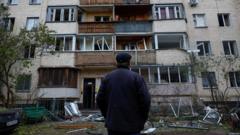Will the EU Transform Frozen Russian Assets into Aid for Ukraine?

Published: 2025-10-23 10:00:17 | Category: technology
The EU is poised to endorse a controversial initiative designed to utilise frozen Russian assets to support Ukraine, dubbed a "reparations loan." This unprecedented plan aims to provide Kyiv with €140 billion (£121 billion) of Russian state assets held by Euroclear, while navigating complex legal and political hurdles. The proposal comes amid dwindling US support for Ukraine and signals a critical moment in the ongoing conflict as the EU seeks to bolster its financial assistance to Ukraine.
Last updated: 26 October 2023 (BST)
What’s happening now
European leaders are set to meet in Brussels on Thursday to discuss the endorsement of a significant proposal to use frozen Russian assets for Ukraine's financial support. This plan, termed a "reparations loan," is primarily viewed as a response to the urgent need for greater financial assistance for Ukraine, particularly as the conflict extends into its fifth year with no clear resolution in sight. The EU has already provided substantial aid, with around €177.5 billion (£154 billion) distributed to support Ukraine since the onset of the invasion, but the necessity for additional funds is pressing.
Key takeaways
- The EU plans to endorse a "reparations loan" using frozen Russian assets, amounting to €140 billion (£121 billion).
- Belgium has expressed concerns regarding the legal implications and risks associated with using these assets.
- Ukraine is pushing for flexibility in how it can utilise the funds, prioritising its own recovery needs.
Timeline: how we got here
The proposal to use frozen Russian assets has been in the works for several months, with increasing urgency as the conflict continues. Key dates include:
- February 2022: Russia launched its full-scale invasion of Ukraine, leading to significant sanctions and the freezing of approximately €210 billion (£182 billion) in Russian investments by the EU.
- Spring 2024: The EU began using interest from frozen assets for Ukraine's defence, amounting to around €3 billion per year.
- October 2023: EU leaders plan to discuss and potentially endorse the "reparations loan" at a summit in Brussels.
What’s new vs what’s known
New today/this week
The latest developments include the EU's move to potentially approve a formal legal proposal for the "reparations loan" that would channel frozen Russian assets directly to Ukraine. Belgium's hesitations about the risks involved in this plan remain a subject of discussion, though they have not ruled it out entirely.
What was already established
It is already known that the EU has frozen significant Russian assets since February 2022 and has been using the interest from these holdings to support Ukraine. However, the notion of repurposing the principal amount as a loan introduces a new dimension fraught with legal and diplomatic complexities.
Impact for the UK
Consumers and households
The UK's consumers may feel indirect impacts through fluctuations in energy prices and economic stability as the EU navigates this proposal. Potential retaliatory measures from Russia could also affect trade relationships and the broader economic landscape.
Businesses and jobs
For UK businesses, especially those involved in international trade or finance, any adverse reactions from Russia could disrupt supply chains and market stability. Companies with ties to European investments may also face increased scrutiny and risk.
Policy and regulation
The UK government will be watching the EU's moves closely, as the implications of this plan could influence future foreign policy and defence spending discussions in Westminster, especially in relation to support for Ukraine.
Numbers that matter
- €140 billion (£121 billion): The amount of frozen Russian assets proposed for use as a "reparations loan" to Ukraine.
- €177.5 billion (£154 billion): Total financial support provided by EU member states to Ukraine as of July 2023.
- €210 billion (£182 billion): Total frozen Russian investments by the EU since the invasion began.
- €3 billion: Annual interest from frozen assets currently used for Ukraine's defence.
- $486 billion (£365 billion; €420 billion): Estimated cost for Ukraine's reconstruction and recovery.
Definitions and jargon buster
- Reparations loan: A financial arrangement to provide funds to a country with the expectation that these funds will be repaid through damages from the aggressor once hostilities cease.
- Sovereign bonds: Loans made to a government, which must be paid back over time, often with interest.
- Euroclear: A financial services company based in Belgium that acts as a clearing house for securities transactions.
How to think about the next steps
Near term (0–4 weeks)
In the immediate future, EU leaders will need to navigate the discussions around the "reparations loan" proposal, addressing concerns from member states, especially Belgium. A consensus will be crucial for moving forward with the initiative.
Medium term (1–6 months)
Assuming the proposal is approved, the EU will need to develop a formal legal framework to execute the loan and establish repayment terms, potentially requiring negotiations with Russia regarding the conditions for repayment.
Signals to watch
- The outcome of the EU summit on 26 October 2023 and any statements from Belgium regarding its position.
- Reactions from Russia to the proposed use of its assets.
- Subsequent discussions within EU member states about the implementation of the loan and its legal ramifications.
Practical guidance
Do
- Stay informed on developments regarding EU financial policies and their implications for international relations.
- Consider the potential economic impacts of the EU's decisions on UK businesses and the broader economy.
- Support measures that contribute to humanitarian assistance for Ukraine while balancing geopolitical risks.
Don’t
- Ignore the potential backlash from Russia and its implications for European security and economic stability.
- Assume that all EU member states will unanimously support the proposal; internal divisions may arise.
- Overlook the legal complexities surrounding sovereign assets and their potential consequences for international law.
Checklist
- Review updates from the EU regarding the "reparations loan" proposal.
- Monitor reactions from Russia and other nations regarding the EU's financial strategies.
- Evaluate the potential impact on UK businesses involved in international trade.
- Engage with local representatives to express your views on international support for Ukraine.
- Stay aware of the broader geopolitical landscape as it develops.
Risks, caveats, and uncertainties
While the "reparations loan" could provide immediate financial relief to Ukraine, several risks accompany this approach. The legal challenges of using frozen sovereign assets raise questions about the potential for litigation from Russia. The EU's strategy may also set a troubling precedent for future international asset management, leading to concerns about financial stability in the broader global market. Furthermore, the success of this initiative hinges on Ukraine's ability to win the war and secure reparations from Russia, which remains uncertain.
Bottom line
As the EU considers leveraging frozen Russian assets to support Ukraine, the outcome of this proposal could have far-reaching implications for international finance and geopolitical relations. The balancing act of providing necessary support to Ukraine while managing the risks associated with such a move is crucial for both EU stability and the broader economic landscape. Stakeholders must remain vigilant as negotiations unfold.
FAQs
What is the "reparations loan" proposal?
The "reparations loan" proposal involves using frozen Russian assets to provide financial support to Ukraine, with the expectation that Ukraine will repay the loan through reparations once the conflict is resolved.
How much funding is Ukraine expected to receive from this plan?
Ukraine is expected to receive €140 billion (£121 billion) in frozen Russian assets under the proposed "reparations loan."
What are the legal implications of using frozen Russian assets?
Using frozen Russian assets poses legal challenges, as sovereign assets cannot be outright confiscated. The EU may need to implement a framework that allows for the borrowing of these funds while respecting international law.



